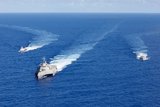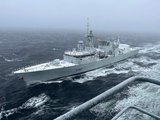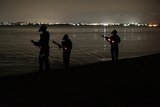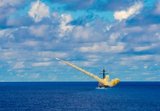Blighter enhances radar coastal security effectiveness
Blighter Surveillance Systems has introduced a number of new features to its Blighter e-scan radar to improve its effectiveness for coastal and harbour security, the company announced on 6 November.
Blighter has enhanced the radar to enhance its ability to protect complex coastlines against threats with the addition of a sea wave clutter filter. The system can now detect and locate targets such as pirates and terrorists using small craft - jet skis, kayaks and rigid inflatable boats (RIBs) - at ranges of up to 10km in almost all weather conditions, in rough seas, heavy rain or dense fog.
The Blighter low power solid state passive electronic scanning array radar features frequency modulated continuous wave (FMCW) transmission technology combined with sensitive Doppler target detection. The sea clutter filter enables the Doppler signal processing unit to filter out sea wave clutter returns in both velocity and amplitude.
Mark Radford, CEO, Blighter Surveillance Systems, said: ‘Protecting coastlines from illegal intruders is a growing concern for countries the world over. Our Blighter coastal security radar’s unique algorithms and Doppler signal processing enables it to detect the small and uncooperative targets that traditional coastal surveillance radars such as vessel traffic systems and maritime radars are simply not designed for.
‘As colour is to CCTV images, Doppler is to radar detection. It adds a third dimension to target detection so that not only are targets identified in azimuth (compass bearing) and range but they are also discriminated by Doppler velocity, the relative speed of each target. The sea clutter filter automatically classifies the sea clutter and removes it and uses a non-moving target detection filter to extract static targets from the Doppler filter enabling it to detect static boats, buoys and other features in a coastal or port environment.’
The Blighter radar transmits only 4 Watts of power and consumes just 100 Watts allowing operation via solar panels and easy installation in difficult areas to reach such as rocky or inaccessible coastal regions. The radar’s low data bandwidth requirement also allows remote operation over narrowband wireless links or satellite communication systems.
Blighter integrates with a range of electro-optic camera systems – and other situation awareness sensors - and these elements are controlled through the BlighterView HMI command and control (C2) software platform. BlighterView can also integrate with AIS transponders, PIDS systems, fusion and target/video tracking elements.
More from Naval Warfare
-
![US Navy to acquire micro-uncrewed underwater vehicles for ISR and coastal data collection]()
US Navy to acquire micro-uncrewed underwater vehicles for ISR and coastal data collection
The Naval Supply Systems Command is seeking authorised resellers of JaiaBot uncrewed underwater vehicles and multivehicle pods. The platforms will support undergraduate education at the US Naval Academy.
-
![NATO tests use of “undetectable, jam-proof” laser communication in maritime scenarios]()
NATO tests use of “undetectable, jam-proof” laser communication in maritime scenarios
As part of its effort to better prepare its capabilities for operations in contested and congested scenarios, NATO evaluated a Lithuanian ship-to-ship terminal designed to not be susceptible to enemy interference.
-
![US Navy advances with the Harpoon Service Life Extension Programme]()
US Navy advances with the Harpoon Service Life Extension Programme
The US Navy plans to improve Harpoon’s anti-ship and land attack capabilities by equipping the missiles with sensors and technologies required for succeeding in future battlespace.





















